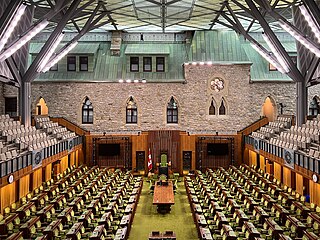
The House of Commons of Canada is the lower house of the Parliament of Canada. Together with the Crown and the Senate of Canada, they comprise the bicameral legislature of Canada.
Elections Canada is the non-partisan agency responsible for administering Canadian federal elections and referendums. Elections Canada is an office of the Parliament of Canada, and reports directly to Parliament rather than to the Government of Canada.

Stormont—Dundas—South Glengarry is a federal electoral district in Ontario, Canada, that has been represented in the House of Commons of Canada since 1968.

Vancouver Centre is a federal electoral district in British Columbia, Canada, that has been represented in the House of Commons of Canada since 1917. It is the riding with the biggest Japanese community in Canada. As per the 2021 census, 2.4% of the population of Vancouver-Centre is Japanese.
This is a list of past arrangements of Canada's electoral districts. Each district sends one member to the House of Commons of Canada.

An electoral district in Canada is a geographical constituency upon which Canada's representative democracy is based. It is officially known in Canadian French as a circonscription but frequently called a comté (county). In Canadian English it is also colloquially and more commonly known as a riding or constituency.

Beauce is a federal electoral district in Quebec, Canada, that has been represented in the House of Commons of Canada since 1867. In 2006, it had a population of 103,617 people, of whom 82,123 were eligible voters.
Canada holds elections for legislatures or governments in several jurisdictions: for the federal (national) government, provincial and territorial governments, and municipal governments. Elections are also held for self-governing First Nations and for many other public and private organizations including corporations and trade unions. Municipal elections can also be held for both upper-tier and lower-tier governments.

Joliette is a federal electoral district in Quebec, Canada, that has been represented in the House of Commons of Canada from 1867 to 1935 and since 1968.
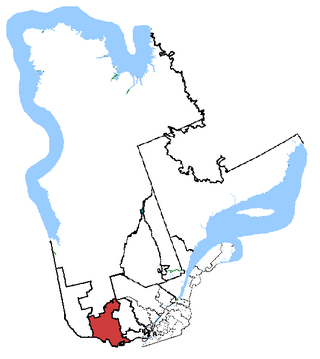
Pontiac is a federal electoral district in western Quebec, Canada, that has been represented in the House of Commons of Canada from 1867 to 1949 and since 1968.
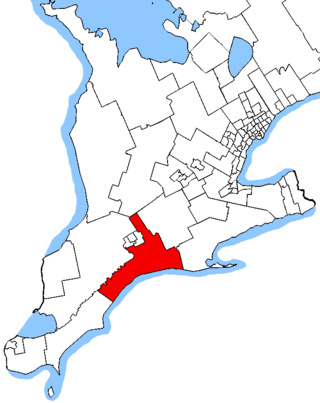
Elgin—Middlesex—London is a federal electoral district in Ontario, Canada, that has been represented in the House of Commons of Canada since 1997.
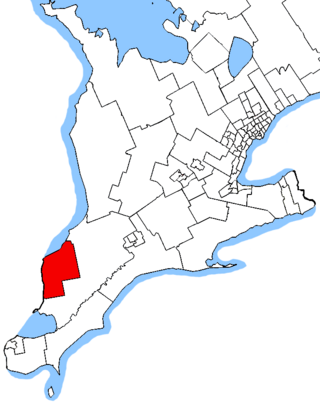
Sarnia—Lambton is a federal electoral district in Ontario, Canada, that has been represented in the House of Commons of Canada since 1968. It is located in the area of the city of Sarnia, in the southwest corner of the province of Ontario.
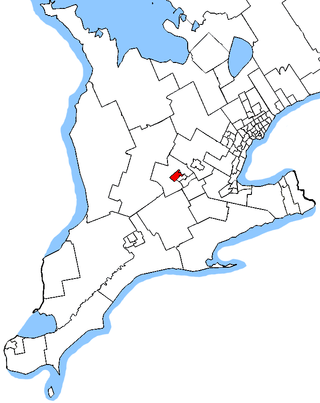
Waterloo is the name of a federal electoral district in the Waterloo Region of Ontario, Canada, that has been used in the House of Commons of Canada from since 1968. Between 1997 and 2015, the riding was known as Kitchener—Waterloo.
A ward is a local authority area, typically used for electoral purposes. In some countries, wards are usually named after neighbourhoods, thoroughfares, parishes, landmarks, geographical features and in some cases historical figures connected to the area. It is common in the United States for wards to simply be numbered.
Electoral reform is a change in electoral systems which alters how public desires are expressed in election results.
The National Register of Electors is a continuously updated permanent database of eligible electors for federal elections in Canada maintained by Elections Canada. It was established in December 1996 when Bill C-63 was granted royal assent and the preliminary National Register of Electors was populated with data in April 1997 during the final Canada-wide enumeration. It replaced a system which required door-to-door enumeration of eligible electors for each electoral event. The database contains basic information about electors: name, address, sex, and date of birth. An elector may register or update their personal information between elections, or may request to be excluded from it per the Canada Elections Act. Eligible expatriate Canadians voters are included in the International Register of Electors.
The federal electoral redistribution of 2012 was a redistribution of electoral districts ("ridings") in Canada following the results of the 2011 Canadian census. As a result of amendments to the Constitution Act, 1867, the number of seats in the House of Commons of Canada increased from 308 to 338. The previous electoral redistribution was in 2003.

Kitchener South—Hespeler is a federal electoral district in the Waterloo Region of Ontario, Canada, that has been represented in the House of Commons of Canada since the 2015 election.

The 45th Canadian federal election will take place on or before October 20, 2025, to elect members of the House of Commons to the 45th Canadian Parliament. The date of the vote is determined by the fixed-date provisions of the Canada Elections Act, which requires federal elections to be held on the third Monday in October in the fourth calendar year after the polling day of the previous election, though a current government bill proposes to postpone the date to October 27, 2025 to avoid conflicting with Diwali. In addition to the statutory fixed election date provisions, Canada has a constitutional requirement specified in both section 50 of the Constitution Act, 1867 and section 4 of the Canadian Charter of Rights and Freedoms that elections for the House of Commons must be held no more than five years after the preceding election.











